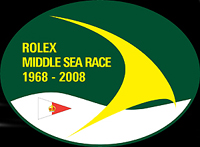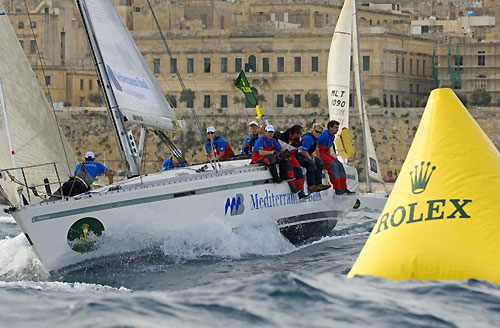




 |
Rolex
Middle Sea Race 2008 Valletta, Malta October 18, 2008. |



Photos By Kurt Arrigo and Carlo Borlenghi for Rolex.
Edited by Peter Andrews.
Edited by Peter Andrews.
October
16, 2008.

|
Saturday marks the fortieth anniversary of the Rolex Middle Sea Race. The 607 nautical mile course has attracted another international fleet ranging from the all pro-crew to the Corinthian, from the adventurers to the highly competitive, and, from the novice to the experienced. Even the local Maltese participants, for whom this race is a defining moment in the sporting calendar, add to the mix of competitors especially in the experience department.
Eleven out of the eighty registered boats are Maltese, and Arthur Podesta and Jonathan Gambin are two of the local skippers. One is a legend, one is a newcomer. One has the benefit of 28 races under his belt, one has only a single race. One has seen it all, one is just starting out. Both though have a similar, simple aim. Complete the course and with a bit of luck do so in the best time possible. |
||
 |
||
|
||
 |
||
|
Podesta, owner and skipper of Elusive
Medbank, did the first race in 1968 on a small, 36-foot
S&S design Swan 36, Josian. Josian won the inaugural race and Podesta's love affair with the course that takes the fleet on a circumnavigation of Sicily had begun. He puts his interest in sailing down to his father, but his enthusiasm for racing down to John Ripard, skipper of Josian and John's brother, Paul, who was on Stormvogel the first boat to finish in 1968. So, who better to ask than Podesta about changes in the race since its early days.
"There have been enormous changes, particularly in the number of boats. In the first race there were eight and in this one we have eighty registered. A huge achievement for the Royal Malta Yacht Club to see the race improve and triumph in such a way" said Podesta. Other changes are apparent too, making today's race almost unrecognisable from the first, as Podesta continues. "The design of the boats - look at the speeds of the boats. In the first race we took over a week, now the fastest boat has done the race in 48 hours. The quality of the sails - in 1968 Dacron was state of the art. I expect there are some who have never heard of Dacron! Now it is all Mylar, Kevlar, carbon and combinations of the like. Navigation equipment - it only takes a few seconds to get position information now and what about weather forecasting - 40 years ago no one knew what was going to happen in the next twelve hours. You went out really not knowing what to expect. Now you have reasonably accurate forecasting for 4 to 5 days. Waterproof clothing is another improvement, it was miserable back then when it was wet." According to Podesta some things will never change, in particular the spirit within the fleet and the enthusiasm of the people taking part and who organize the event. For Podesta the race is as exciting today as it was forty years ago. "Forty years on I still enjoy preparing my boat for the race and I still get the adrenalin rush and the butterflies during the pre-start. My enthusiasm is undiminished and is now spurred on by the involvement of my children who race with me and form the core of my crew." Asked how many more races he thinks he might do Podesta is coy, though it is clear he has no intention of stopping any time soon, "certainly whilst I have my health," he laughs. |
||
 |
||
|
||
 |
||
|
And
it is plainly the spirit and the thrill of the challenge that attracts
newcomers like Jonathan Gambin, owner and skipper of the Dufour
44, Ton Ton. Drawn by the sense of
achievement to be gained, the attraction of being part of something
special and deep down even the possibility of glory. Make no mistake,
everyone no matter how small their chance wants to win the Rolex
Middle Sea Race and the concept of every dog has its day is not
lost on the fleet. Gambin has been sailing for a while, but is
new to the race and racing.
"I have done some cruising before and have done some long passages, but this will be the first time I'll be skipper of my own boat on such a long race. I only took up competitive sailing three years ago and in 2006, did the race as crew on a boat called Geisha. The conditions were similar to those predicted for this year, which are light for the first few days and probably increasing from Thursday." Coincidentally, Gambin had planned to do the race last year with Arthur Podesta, but injured his hand and was unable to go. He seems quite glad given the way it turned out. Although he is a relative novice, Gambin seems well prepared and gives the impression of having done his homework. Hardly surprising, perhaps, given the amount of knowledge about the race available on this small island. Plus, Gambin has had the advantage of watching the start and finish of the race for a number of years from his restaurant overlooking the water. The restaurant has other benefits too. "The catering will be good because I own a restaurant, so we are preparing some pre-cooked meals that will be frozen and put in the fridge to thaw out during the race. We'll have at least one good meal a day." No freeze-dried food for the crew of Ton Ton. Gambin has enjoyed the lead up to the race and preparing his boat, although he confesses to having enlisted support. He intends to be competitive, but he is realistic in his chances. "I am very pleased with the boat, she is more race oriented than my last one, but that is relative to some of this fleet who fly in the light. I'm not sure we have all the right sails - maybe our biggest genoa is a little smaller than we would like for the light winds. But our crew work is getting better. We raced yesterday and that has helped a lot moulding the team together. I think in a long-distance race one has less pressure to do manoeuvres quickly and so if we lose a minute here or there it will not be so critical. We have a reasonable crew. Some local Maltese, including one complete beginner, three Italians, one of whom has good experience of the race, and an Australian." |
||
 |
||
|
||
 |
||
|
The
start in Marsamxett Harbour is like no other. The natural amphitheatre
formed by the bastions of Valletta and Manoel Island is a unique
starting arena, and creates an added piquancy to an already electric
moment. For Gambin the start is the best part of any race. He relishes
the excitement and adrenalin.
"I always want to be first across the line!" he says. He knows well that the Rolex Middle Sea Race will not be won or lost in this moment. In fact, he has his own theory on the key period in the course. "In my opinion the critical moment in the race will be between Favignana and Pantelleria. The opportunity to go off on the wrong tack is huge, but so is the chance to get it right. The boat I was on in 2006 made a mistake and paid for it. Hopefully, we will get it right this year." One thing is for certain, Gambin shows the early signs of addiction to the race and its allure, stating firmly, "whatever the result I'll be back again next year." |
||
 |
||
|

The other Maltese competitors registered for the 2008 Rolex Middle Sea Race are: AirMalta Falcon - Jackie Scicluna Aziza - Sandro Musu Artie - Lee Satariano Escape - Georges Bonello DuPuis Lazy Duck - John Ripard Jr Gasan Mamo Comanche Raider II - Jonas Diamentino Strait Dealer - David Franks Vikesha - Tim Camilleri Windriven - Ivan Mallia The 29th Rolex Middle Sea Race commences on Saturday 18th October 2008 from Marsamxett Harbour, Malta. The Malta Rolex Cup on the 15th October will precede the main race. The final prize giving is at noon on 25th October. George David's Rambler (USA) established the current Course Record of 47 hours 55 minutes and 3 seconds in 2007. For more information about the Rolex Middle Sea Race 2008 including the entry list, position reports and results please visit www.rolexmiddlesearace.com. |
 |
Outimage and Rolex © 2008 |



 |
||||
 |
||||
 |
||||
|
|
||||
 |
||||
 |
||||
|





